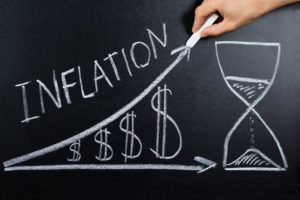Does Vaccinations and $2 Trillion in Fresh Stimulus Mean Inflation?
 Low, practically zero, interest rates have been a boon for growth, mainly due to cheap money enabling massive, once unthinkable debt levels across both the public and private sector. But that cheap money may be coming to an end sooner than many have predicted.
Low, practically zero, interest rates have been a boon for growth, mainly due to cheap money enabling massive, once unthinkable debt levels across both the public and private sector. But that cheap money may be coming to an end sooner than many have predicted.
Corporate debt now exceeds $10.5 TRILLION as for over a decade, super-low interest rates borne by the 2008 financial crisis have made borrowing a no-brainer. Since then, U.S. companies have regularly offered up bonds for sale, taking advantage of the cheap access to cash. Corporations, the Federal Reserve and the U.S. Government are keenly aware of the danger of not being able to service its record-breaking debt if the Fed raises rates.
But ‘if’ has become a question of when. According to Bloomberg “The bond market is about to get a serious reality check, with traders leaning heavily toward higher long-term yields and also a scenario where the Federal Reserve starts lifting rates from near zero well before officials now envision.”
“The 10-year breakeven inflation rate — a market proxy for annual consumer price inflation for the next decade, is around 2.25%, near the highest since 2014. Investors are betting on quicker inflation in part as the Fed’s new monetary-policy approach will allow for inflation to run hot — over 2% — for some time.”
One doesn’t have to be an ‘economist’ to understand that cheap money stimulates borrowing, thus residential homes once considered unaffordable are now manageable with 2-3% rates, leading to the supply and demand formula for an 11-year appreciation.
Many are now asking what happens to both the market and servicing existing debt when low rates are no longer available?
The prices go higher while the cost of borrowing also increases.
Markets could see a healthy, much overdue contraction, but, as the Fed has flooded the economy with cash, history shows the cost of goods and services always increases. Consumers no longer stretch into that next level of car, home, furnishings, etc. and in unison, all hit the pause button on making a purchase.
The double whammy of high prices and higher costs of borrowing cause small business owners to face the almost impossible choice of raising prices and potentially losing market share or having to make cuts internally.
Business owners can hedge against the gradual rise in long-term rates by restructuring their existing business debt today. For more details contact Valcor today.
Topics: Economy, Fiscal Policy, , Bloomberg, bonds, borrowing, CNBC, Debt, Fed, inflation, interest rates, Small business, Stimulus







